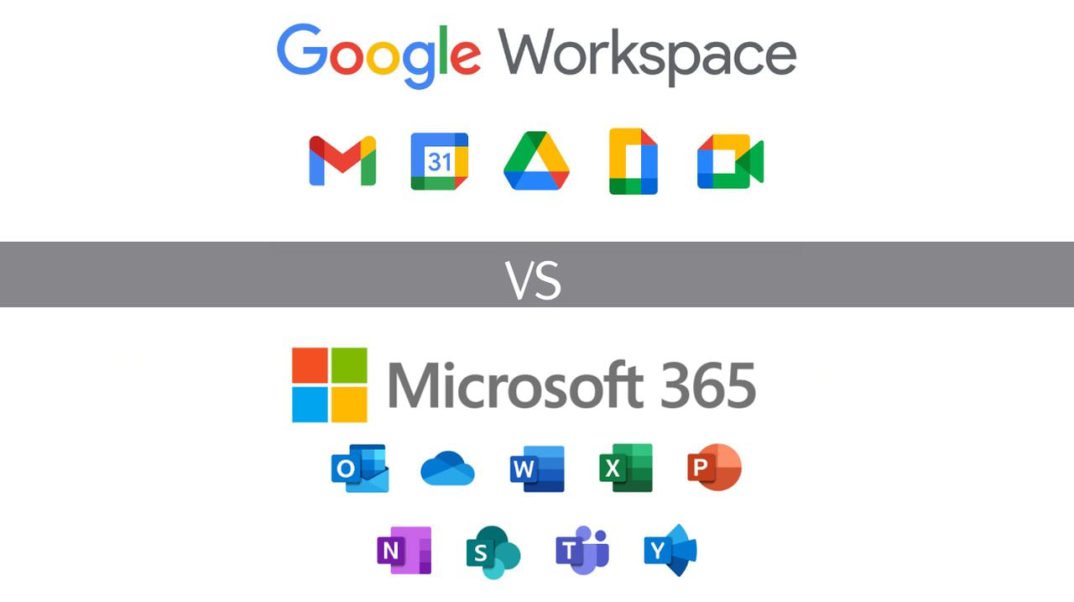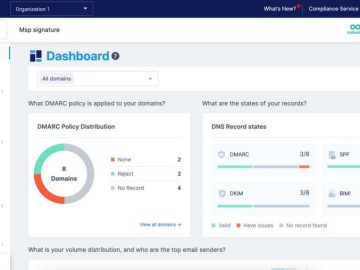Choosing between Google Workspace and Microsoft 365 for your business’s productivity and email hosting needs can be a daunting task. Both platforms offer a comprehensive suite of tools designed to streamline workflows, enhance collaboration, and improve overall efficiency. However, each has its own strengths and weaknesses that may make one more suitable for your specific requirements.
Key Takeaways :Setup Process:
- Google Workspace: Simple, user-friendly setup; default to most expensive plan.
- Microsoft 365: Requires temporary domain setup, adding complexity but thorough.
User Management:
- Microsoft 365: Beginner-friendly interface, ideal for limited technical expertise.
- Google Workspace: Complex at first, but offers advanced management capabilities.
Email Hosting:
- Google Workspace: Gmail with excellent deliverability and spam filtering.
- Microsoft 365: Outlook is reliable and feature-rich but slightly behind Gmail.
Productivity Features:
- Google Workspace: Integrated tools (Docs, Sheets, Slides, Drive, Meet) for seamless collaboration.
- Microsoft 365: Comprehensive suite (Word, Excel, PowerPoint, OneDrive, Teams) with 1TB storage per user and desktop apps.
Trials and Pricing:
- Google Workspace: 14-day trial; flexible pricing, limited to specific markets.
- Microsoft 365: 30-day trial; annual plans with monthly payment options.
Higher Plans:
- Google Workspace: Increased storage and larger Meet participant limits.
- Microsoft 365: Desktop apps and webinar hosting in Business Standard Plan.
Nonprofits:
- Google Workspace: 100TB shared storage for up to 2,000 users.
- Microsoft 365: Free for up to 300 users.
Suitability:
- Google Workspace: Best for email deliverability, Google integration, user-friendly collaboration.
- Microsoft 365: Best for comprehensive suite, generous storage, desktop apps, advanced features.
In this overview guide and video created by Craylor Made, we’ll take a closer look at the main key aspects of these two online powerhouses, including their setup processes, user management capabilities, email hosting reliability, and productivity features, to help you make an informed decision that aligns with your business goals.
Google Workspace vs Microsoft 365
Getting started with either Google Workspace or Microsoft 365 is a relatively straightforward process, thanks to their user-friendly setup wizards. Google’s setup process is known for its simplicity and smooth navigation, guiding you through each step with ease. However, it’s worth noting that the default settings lean towards the most expensive plan, requiring manual adjustment if you prefer a more cost-effective option. On the other hand, Microsoft’s setup involves an additional step of setting up a temporary domain, which may add a slight layer of complexity. Nevertheless, this extra step ensures a thorough configuration, leaving no stone unturned.
Intuitive User Management
Effective user management is a critical component of any productivity suite, as it allows administrators to maintain control over access, permissions, and security. Microsoft’s user dashboard stands out for its beginner-friendly interface, presenting a simplified view that is easy to navigate and understand. This makes it an ideal choice for businesses with limited technical expertise or those new to cloud-based productivity platforms. In contrast, Google’s user management dashboard may appear more complex at first glance, potentially requiring a steeper learning curve for beginners. However, it offers a wealth of advanced management capabilities that experienced users will appreciate, providing granular control over user accounts and settings.
Here are a selection of other articles from our extensive library of content you may find of interest on the subject of Microsoft 365 :
Reliable Email Hosting
Email hosting is a make-or-break factor for many businesses when selecting a productivity suite. Google Workspace uses the power of Gmail, renowned for its exceptional deliverability rates and robust spam filtering capabilities. With Gmail, you can rest assured that your important messages will reach their intended recipients while minimizing the risk of unwanted spam cluttering your inbox. Microsoft 365, on the other hand, relies on Outlook for email hosting. While Outlook is a reliable and feature-rich email client, it may not quite match Gmail’s reputation for deliverability. Nevertheless, both services provide top-notch email hosting solutions that cater to the needs of modern businesses.
Powerful Productivity Features
When it comes to productivity features, both Google Workspace and Microsoft 365 showcase their strengths in unique ways. Google Workspace offers a seamlessly integrated ecosystem that includes:
- Google Docs for word processing
- Google Sheets for spreadsheets
- Google Slides for presentations
- Google Drive for cloud storage
- Google Meet for video conferencing
These tools work together harmoniously, allowing teams to collaborate effortlessly and access their files from anywhere, at any time. On the other hand, Microsoft 365 features its own impressive lineup of productivity apps:
- Microsoft Word for document creation
- Microsoft Excel for data analysis
- Microsoft PowerPoint for engaging presentations
- OneDrive for secure file storage and sharing
- Microsoft Teams for unified communication and collaboration
One notable advantage of Microsoft 365 is its generous storage allocation. With 1TB of cloud storage per user in its base plan, compared to Google’s 30GB, Microsoft 365 emerges as a compelling choice for businesses with extensive storage requirements. Moreover, Microsoft’s inclusion of desktop versions of its Office apps adds an extra layer of flexibility and functionality for users who prefer the familiarity of traditional desktop software.
Trial Periods and Pricing Flexibility
Before committing to either platform, it’s wise to take advantage of the free trial periods offered by both Google Workspace and Microsoft 365. These trials allow you to explore the features, test drive the user interface, and assess how well each suite integrates with your existing workflows. Microsoft provides a generous 30-day free trial, giving you ample time to evaluate its capabilities. Google, on the other hand, offers a 14-day trial period, which may be sufficient for businesses that are already familiar with Google’s ecosystem.
When it comes to pricing, both services offer flexible options to suit various budgets and requirements. Microsoft 365 stands out for its annual commitment plans with monthly payment options, providing a balance between long-term value and short-term flexibility. Google Workspace also offers similar pricing structures, but availability may be limited to specific markets. It’s crucial to carefully review the pricing plans and consider your business’s unique needs and growth trajectory when making a decision.
Elevate Your Productivity with Higher Plan Options
As your business grows and evolves, you may find that upgrading to higher plan options can significantly enhance your productivity and collaboration capabilities. Microsoft’s Business Standard Plan is a noteworthy example, as it includes desktop versions of the Office apps and the ability to host webinars. This can be particularly valuable for businesses that heavily rely on Microsoft’s ecosystem and require advanced features for their day-to-day operations. On the other hand, Google’s higher-tier plans offer increased storage capacity and support for larger Google Meet participant limits. This can be a catalyst for businesses with extensive collaboration needs, allowing seamless virtual meetings and efficient teamwork.
Empowering Nonprofits with Tailored Offerings
For nonprofit organizations, both Google Workspace and Microsoft 365 extend generous plans designed to support their unique needs. Google’s nonprofit offering is particularly impressive, providing a whopping 100TB of shared storage for up to 2,000 users. This can be a lifeline for large nonprofit organizations that handle vast amounts of data and require ample storage space. Microsoft’s free offering for nonprofits, while still valuable, is limited to 300 users. This may be sufficient for smaller nonprofits with more modest requirements, but larger organizations may find Google’s offering more appealing.
Making the Right Choice for Your Business
In the end, the decision between Google Workspace and Microsoft 365 boils down to your business’s specific needs, existing infrastructure, and future goals. If seamless email deliverability and deep integration with Google’s ecosystem are top priorities, Google Workspace emerges as a strong contender. Its user-friendly interface, collaborative tools, and robust email hosting make it a popular choice for businesses of all sizes.
On the other hand, if your business demands a comprehensive productivity suite with generous storage, desktop app functionality, and advanced features, Microsoft 365 may be the way to go. Its familiar interface, powerful Office apps, and extensive third-party integrations make it a versatile choice for businesses that rely heavily on the Microsoft ecosystem.
Ultimately, the best approach is to carefully evaluate your business’s unique requirements, consider the strengths and limitations of each platform, and take advantage of the free trial periods to gain hands-on experience. By doing so, you’ll be well-equipped to make an informed decision that aligns with your business objectives and sets the stage for long-term productivity and success.
Video Credit: Source
Filed Under: Guides
Latest Geeky Gadgets Deals
If you buy something through one of these links, Geeky Gadgets may earn an affiliate commission. Learn about our Disclosure Policy.
Originally Appeared Here





